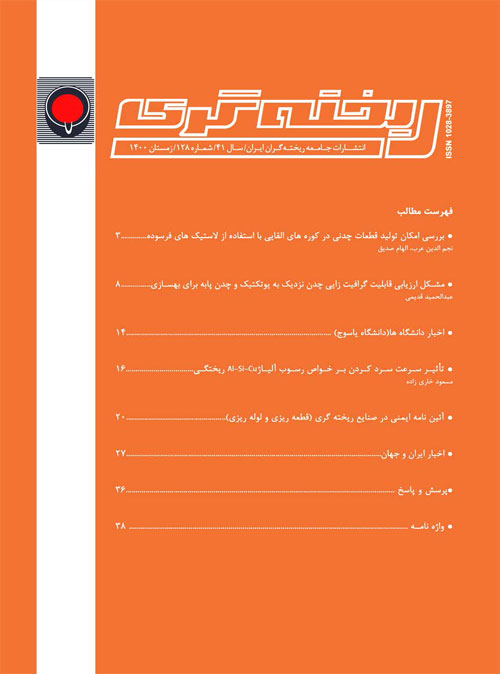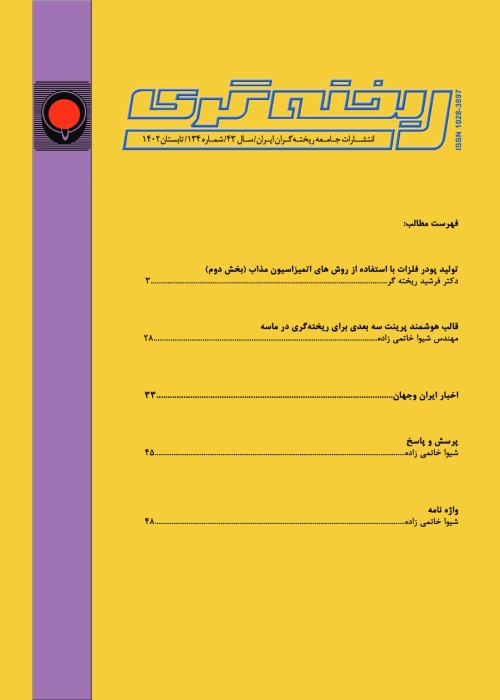فهرست مطالب

نشریه ریخته گری
پیاپی 128 (زمستان 1400)
- تاریخ انتشار: 1401/03/10
- تعداد عناوین: 9
-
-
بررسی امکان تولید قطعات چدنی در کوره های القایی با استفاده از لاستیک های فرسودهصفحه 3
-
مشکل ارزیابی قابلیت گرافیت زایی چدن نزدیک به یوتکتیک و چدن پابه برای بهسازیصفحه 8
-
اخبار دانشگاه هاصفحه 14
-
تاثیر سرعت سرد کردن بر خواص رسوب آلیاژ ریختگی Al-Si-Cuصفحه 16
-
آئین نامه ایمنی در صنایع ریخته گری (قطعه ریزی و لوله ریزی)(قسمت اول)صفحه 20
-
اخبار ایران و جهانصفحه 27
-
پرسش و پاسخصفحه 36
-
واژه نامهصفحه 38
-
لیست اعضاء حقوقی فعال جامعه ریخته گران ایرانصفحه 43
-
Investigation to Production of Cast Irons in Induction Melting Furnaces by Worn TiresPage 3
Rubber recycling methods are divided into two branches, mechanical and chemical. In the mechanical method, tires are divided into smaller pieces. This is done in several stages by shredders and mills. Each step of this method produces different products that are used in different industries. Some industries use coarse granules and others require very soft rubber powder. In the chemical method, either the tire is burned and the remaining coal and metal wires are used or the tire is pyrolyzed. In the pyrolysis method, the tire is burned in vacuum. In this method, products such as fuel (fuel such as diesel), oil, etc. are extracted. Recently, tires have been used as a source of heat and carbon in the smelting of steel and cast iron. This method has been used successfully in electric arc furnaces for melting steel. The aim of this study was to investigate the possibility of carbon adsorption of worn tires to the molten cast iron in induction furnaces and the effect of adding carbon through worn tires on the microscopic properties and structure of cast irons. In the first stage of the research, the desired tire weight was determined by performing calculations. The amount of molten carbon was measured without adding rubber, then the tires were added in different weights and the percentage of carbon obtained was obtained and the amount of carbon adsorption was measured. Then the desired samples were cast and the percentage of carbon in the samples was determined. The results show that the percentage of carbon uptake was was very low and the spilled samples were full of cavities and porosity. Burning rubber and producing a large amount of gas pollutes the workshop environment and spills melt out of the pan. The main conclusion is that this method can not be used to increase carbon in induction furnaces.
Keywords: Worn tires, Cast iron, Induction furnace, Carbon addition -
The Problem of Assessing the Graphitizing Abilities of Near-eutectic Cast Iron - Basic Cast Iron for ModificationPage 8
-
Universities introducing (Yasuj univercity, Islamic Azad University of MashhadPage 14
-
Effect of Cooling Rate on the Precipitation Characteristics of Cast Al–Si–Cu AlloysPage 16
-
Safty regulations in foundry industriesPage 20
-
Iran & World newsPage 27
-
Question& AnswerPage 36
-
LexiconPage 38


